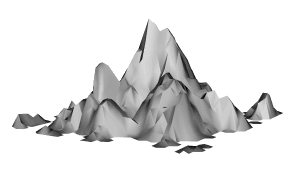i-How: Science - How does weathering work
Weathering is the breaking down of rocks by natural forces. There are three different types of weathering. Chemical weathering mainly occurs in warm and wet climates. Water, oxygen and acid can all weather rocks away. They breakdown rocks by dissolving or reacting with some of the minerals in the rock. Water attack Water itself can cause chemical reactions with some rocks. Water attacks one of the minerals in granite, for example. The granite break down into tiny particles of clay. These then get washed away. Oxygen attack Oxygen gas in the air can attack some rocks, particularly those containing iron. The rusty brown streaks in some rocks are due to iron reacting with oxygen. This leads to the formation of iron compounds which causes weakness in the rocks, hence the rocks wear away.
Weathering
Chemical Weathering
Chemical Weathering image courtesy of science-resources.co.uk
Chemical Weathering: Acid Rain
Chemical weathering is not just due to "acid rain" caused by pollution, it is also instigated by ordinary rain. You probably think that rain-water is pure. Actually it is slightly acidic. This is because carbon dioxide gas dissolves in rain as it falls. The resulting weak acid (carbonic acid) attacks rocks, mainly those containing calcium carbonate. Calcium carbonate, in limestone, reacts with carbonic acid:
Calcium carbonate + carbonic acid calcium hydrogencarbonateCaCo3(s) + H2CO3(aq) Ca(HCO3)2(aq)
Soluble calcium hydrogencarbonate is formed. So the limestone is slowly worn away.
Physical Weathering
Physical weathering mainly occurs in deserts and high mountains. Change in temperature can break up rocks. When rocks are subjected to continuous hot and cold spells, they expand and shrink. Most rocks are made from mixtures of minerals. These expand and shrink at different rates. This causes stress to build up in rocks. Eventually, they crack and crumble away. This is known as stratification. To demonstrate this effect, we can heat a glass rod and drop it into cold water. See animation below:
Heated Rod and Breaking Glass image courtesy of science-resources.co.uk
In regions where the temperature drops below 0°C , ice can weather rock away
When it rains, water collects into the cracks in rocks. If the temperature drops below freezing, it turns into ice and expands. The expansion effect of ice pushes the rocks apart. This is repeated as water thaws and freezes. Eventually the pieces of rock break off by fracturing or shattering and fall to the lowest point on the ground. This process is called Freeze thaw. The broken off pieces of rock are called Scree.
|
Weathering image courtesy of science-resources.co.uk
Plants and animals are also responsible for breaking up rocks. Soil can gather in the cracks of rocks and if seeds land there, plants can grow. The roots of the plants push their way through the cracks of rocks and as the roots grow they gradually push the rocks apart. See animation opposite. Burrowing animals and humans also wear away rocks as they dig.
Biological weathering - caused by plants and animals
Biological Weathering image courtesy of science-resources.co.uk
Erosion And TransportErosion is different from weathering, as it is the wearing away of exposed rocks by other moving rocks, via any means. The weathered rocks (pieces of broken rocks) are often found a long distance from the original rocks. These rocks come in different shapes and sizes. The transportation of these rocks can happen in four different ways.
Gravity
The wind
Rivers and seas - moving water
Glaciers - moving ice
Rock Fall image courtesy of science-resources.co.uk
Gravity: The gravitational pull of the Earth can move any shape or size of rocks. It moves the rock to the lowest point on the land. From here on, other forces can move the rock further still, from it original place.
Wind: It can only carry small grains, like sand in desert storms. Continuous bombardment, over thousands of years, by these small grains can erode away rocks, particularly softer ones.
Rivers: The speed of the flowing water determines which fragment is moved. Rivers usually flow quickly near their origin in the mountains. They slowdown as they approach the sea. Fast moving water in rivers can move small rocks and stones along the bottom. These moving rocks and stones carve out V-shaped valleys in the eroded land. Slow moving water can only carry small particles along, for example sand and other sediments.
Seas: Costal erosion is predominantly caused by the sea. The force of the sea waves, mixed with stones and pebbles 'chip' away against the coastline. Cliffs can be eroded above and below the water levels. The rounded rocks you encounter on the pebbly beaches are the result of constant bashing and rubbing of rocks against each other as waves, currents and tides move them backwards, forwards and along the beach.
Glaciers: These ice river are very slow moving, about a meter per day. Nevertheless, they are more effective at eroding rocks, which they pass over, than rivers. This is due to the ability of glaciers being able to carry along rocks of all sizes. They can even pull along large boulders. These scrape away the rock along the bottom of the glacier. This results in the formation of U-shaped valleys.
What Happens to eroded rock?
The pieces of rock that have been weathered or eroded eventually settle else where. The smaller fragments form the basis of soils. These tiny pieces are usually deposited by slow moving rivers near the sea. Even the fine grains of rock settle to the bottom of the river. These deposited bits are called Sediments.When rivers change course or run dry, they leave the sediments behind, forming fertile soil. The type and quality of soil formed naturally depends on the kind of rock the river has journeyed over. These sediments are the basis of all sedimentary rocks.
Tags: how does weathering work; biological weathering; physical weathering; chemical weathering; weathering; how do weathering and erosion work together, what does weathering mean, chemical weathering acid rain.
